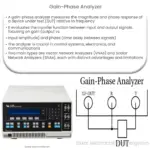Explore Bode plots, their components, benefits, and construction steps. Learn about frequency domain analysis in control systems.
Introduction to Bode Plots
A Bode plot is a powerful graphical tool used in the field of control systems and frequency domain analysis to represent the gain and phase response of a linear, time-invariant system with respect to frequency. It is widely employed in the design and analysis of electronic circuits and control systems to better understand their behavior and performance.
Components of a Bode Plot
A Bode plot consists of two separate plots: the magnitude plot and the phase plot. The magnitude plot shows the system’s gain response in decibels (dB) versus frequency (usually represented on a logarithmic scale), while the phase plot illustrates the system’s phase shift in degrees versus frequency (also on a logarithmic scale).
Benefits of Bode Plots
- Visual representation of the system’s response allows for easy identification of system characteristics and potential issues.
- Frequency domain analysis provides insight into system stability and performance.
- Logarithmic scaling enables a wide range of frequencies to be represented on a single plot.
- Graphical interpretation aids in the design and tuning of control systems, filters, and amplifiers.
Constructing Bode Plots
Constructing a Bode plot involves a series of steps:
- Obtain the system’s transfer function, typically represented as H(s) or G(s), where ‘s’ is the complex frequency variable.
- Substitute ‘jω’ for ‘s’ in the transfer function to convert it into the frequency domain, where ‘j’ is the imaginary unit and ‘ω’ is the angular frequency.
- Separate the resulting expression into real and imaginary components to obtain the magnitude and phase information.
- Plot the magnitude and phase information against frequency using a logarithmic scale for both the x-axis (frequency) and y-axis (magnitude).
Asymptotic Approximations
While exact Bode plots can be generated using mathematical tools and software, engineers often use asymptotic approximations for quick analysis and sketching. Asymptotic approximations involve breaking down the transfer function into simple components (such as poles, zeros, and gain constants) and then constructing the Bode plot using straight lines for each component. These approximations provide valuable insight into the system’s behavior and help in the design process, even though they may not be as precise as exact calculations.
Conclusion
Bode plots are invaluable in the analysis and design of control systems and electronic circuits. By providing a clear graphical representation of a system’s frequency response, they offer engineers a deeper understanding of system behavior and performance, enabling more informed decisions during the design process.
Example of Bode Plot Calculation
Let’s consider a simple first-order low-pass RC filter with a transfer function H(s) given by:
H(s) = 1 / (1 + sRC)
where ‘R’ is the resistance and ‘C’ is the capacitance of the circuit.
Step 1: Convert to Frequency Domain
Substitute ‘jω’ for ‘s’ in the transfer function:
H(jω) = 1 / (1 + jωRC)
Step 2: Separate Magnitude and Phase
Magnitude:
|H(jω)| = 1 / √(1 + (ωRC)2)
Phase:
∠H(jω) = -tan-1(ωRC)
Step 3: Convert Magnitude to Decibels
Magnitude (dB):
20 * log10(|H(jω)|) = -20 * log10(√(1 + (ωRC)2))
Step 4: Plot the Bode Plot
Plot the magnitude and phase response on separate graphs with logarithmic frequency axes.
- Magnitude Plot: Plot the magnitude (dB) against the logarithmic frequency axis.
- Phase Plot: Plot the phase shift (degrees) against the logarithmic frequency axis.
Step 5: Interpret the Bode Plot
Observe the key features of the Bode plot, such as the cutoff frequency (-3 dB point) and the roll-off rate (slope of the magnitude plot).
In this example, the cutoff frequency is given by:
ωc = 1 / RC
At the cutoff frequency, the filter’s gain is reduced by 3 dB, and its phase shift is -45°. The roll-off rate for a first-order low-pass filter is -20 dB/decade, indicating a decrease in gain of 20 dB for every tenfold increase in frequency beyond the cutoff frequency.



